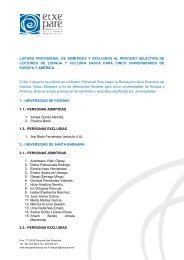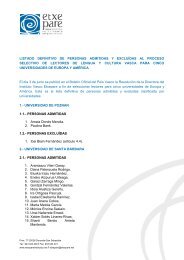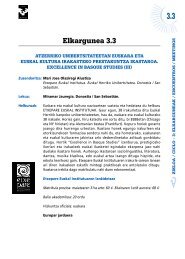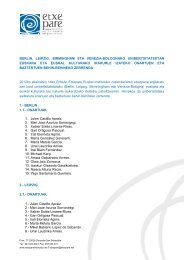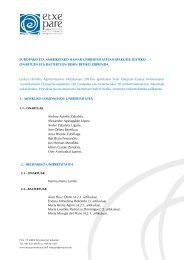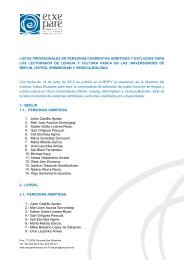Euskal sukaldaritzaz - Etxepare, Euskal Institutua
Euskal sukaldaritzaz - Etxepare, Euskal Institutua
Euskal sukaldaritzaz - Etxepare, Euskal Institutua
You also want an ePaper? Increase the reach of your titles
YUMPU automatically turns print PDFs into web optimized ePapers that Google loves.
tres horas. O más. Debe quedar muy oscuro y la verdura<br />
prácticamente deshecha.<br />
Además, retiramos el tallo a los choriceros y les quitamos<br />
las pepitas. Los colocamos en una cazuela y los<br />
cubrimos de agua, arrimando a fuego suave y debiendo<br />
arrancar el hervor. En el momento que pase, escurrirlos,<br />
volverlos a cubrir de agua y otra vez al fuego, haciéndolo<br />
una tercera vez más. Los dejamos templar y con<br />
ayuda de una cuchara, extraemos la pulpa de pimiento<br />
separándola de la piel (claro que si la vida moderna te<br />
tiene en sus garras, puedes siempre comprar pulpa de<br />
pimiento choricero en lata, aunque si hablamos de salsa<br />
“auténtica”, evidentemente no es buen consejo).<br />
Ya la verdura pochada, retiramos el ramillete de perejil<br />
y añadimos la pulpa de choricero, dando unas vueltas.<br />
Retiramos el hueso o el tocino de jamón y pasamos la<br />
salsa por un pasapurés, o batidora y un colador fino. Si<br />
es necesario y queda muy espesa, la estiramos con un<br />
poco del agua de remojo de los pimientos, para que<br />
quede bien suelta. Rectificamos el sazonamiento, añadiendo<br />
una pizca de sal. Como hemos comprobado, no<br />
añadimos nada de sal al principio, puesto que el hueso<br />
o el tocino de jamón, ya salan suficiente la salsa. Si no<br />
añadiéramos nada de chacina, entonces si deberemos<br />
añadir un poco de sal al inicio.<br />
Hay quienes al final, añaden una galleta María a la salsa,<br />
antes de triturarla, para que ligue, pero no es necesario.<br />
Con esta salsa podemos guisar un bacalao, hacer una<br />
caracolada, hervir unos morros de ternera cocidos y<br />
rebozados o empapar unas manos de cerdo cocidas y<br />
rebozadas.<br />
Si alguien está interesado en la historia de esta salsa,<br />
le recomiendo vivamente la lectura del libro de Jose<br />
Angel Iturbe, La salsa vizcaína. 13 El bueno de Iturbe<br />
se ha tomado el trabajo de buscar todo el material<br />
que hay en torno a esta ilustre salsa y la verdad es<br />
que uno ni se imagina la cantidad de platos que se<br />
han cocinado con ella ni las mesas y países a los que<br />
ha sido capaz de llegar.<br />
En su libro, Iturbe incluye la receta que hacía el<br />
difunto Genaro Pildain, mítico cocinero vizcaíno a<br />
be very dark and the vegetables almost broken down.<br />
Then cut off the stems from the peppers and remove<br />
any seeds. Put them in another pot and cover them with<br />
water. Cook over a low heat until the water begins to<br />
boil. When it boils, drain the pot. Return the peppers to<br />
same pot and cover them with water again. Cook until<br />
the water boils, and then drain again. Repeat the boiling<br />
process once more, then allow the water to cool down<br />
to lukewarm temperature. Using a spoon, carefully remove<br />
the fleshy pulp from the skin of the peppers (Of<br />
course, leading the hectic modern lifestyle you do, you<br />
can always buy this fleshy part of the pepper already<br />
prepared and canned, but if we’re speaking about “authenticity”<br />
then this isn’t good advice).<br />
Once the vegetables have been sweated down, remove<br />
the sprig of parsley and add the fleshy pulp from the<br />
peppers , stirring everything together. Remove the ham<br />
bone or chunk of bacon and pass the sauce through a<br />
food mill, food processor or fine sieve. If necessary and<br />
if the sauce is very thick, thin it out with a little water<br />
from the pot in which the peppers were soaked, so that<br />
it is fairly runny. Season to taste with a little salt. As I<br />
have found out, it is better not to add salt at the beginning<br />
since the ham bone or bacon season the sauce.<br />
If you don’t add any pork product like this, then you<br />
should add some salt at the start.<br />
Some people add a sweet Marie biscuit (similar to a Rich<br />
Tea) to the sauce before processing it to bind it, but this<br />
is not essential. With this sauce, one can make stews<br />
with salt cod and snails. One can also add previously<br />
boiled beef muzzles, which are then rubbed in flour and<br />
a beaten egg and fried, or pigs’ trotters rubbed in flour<br />
and beaten egg and fried, to the sauce.<br />
Anyone interested in the history of this sauce should<br />
definitely consult Jose Angel Iturbe’s La salsa vizcaína<br />
13 (2010). The charming Iturbe has taken the time<br />
out to seek out everything connected to this illustrious<br />
sauce. And the truth is that one cannot imagine<br />
the range of dishes that have used it, or the multiple<br />
tables at which and the countries in which it has<br />
been served.<br />
63



